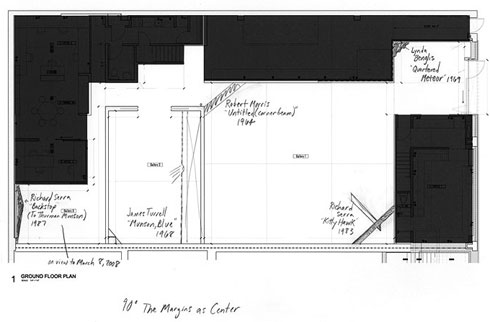
It is in its restriction, spatial limitations, and marginalization that the corner has come to serve as a significant site of creative production. It is the terminus of two walls and the site where floor and ceiling end. It is the furthest point from the center of a room and less brilliantly lit. It is a site of punishment and degradation. Of all the places in a gallery-the walls, the floor, the ceiling-it is perhaps the corner that is the most infrequently used and difficult place to anchor a work. The corner not only defies the flat plane of most painting and photography, but also reduces the workable space of a sculptural object from 360 degrees to just 90 degrees.
Reviewing the exhibition "Cornered" at Paula Cooper Gallery in 1995, which focused primarily on contemporary artists making work during the 1980s and 1990s, art historian Pepe Karmel traces the origins of setting sculpture in a corner to Vladimir Tatlin in 1915 with his work "Corner Relief." Although not cited by Karmel, it is important to note that Kazimir Malevich and Naum Gabo also began exploring the corner around this period with Malevich hanging his painting "Black Square," 1915 across a top corner space in the seminal 1915-16 exhibition "The Last Futurist Exhibition: 0, 10" in St. Petersburg, Russia. Working less architecturally, Naum Gabo created the space of a corner with his sculpture "Head of a Woman," 1917-20. Karmel further notes, that it was only "after a long hibernation" that corner sculptures began to reappear in the 1960s. In our own research we have found it remarkable to see the emergence of sculpture specifically sited in a corner being produced by so many artists from the 1960s such as Carl Andre, Lynda Benglis, Dan Flavin, Eva Hesse, Sol LeWitt, Bruce Nauman, Fred Sandback, Alan Saret, Richard Serra, Robert Smithson, James Turrell, Richard Tuttle, and Lawrence Weiner. Also surprising has been the continued engagement with the corner by artists of later generations working across a spectrum of practices. To name just a few: Janine Antoni, Joseph Beuys, Gordon Matta-Clark, Rachel Whiteread, Joel Shapiro, Adrian Piper, Andre Cadere, Roni Horn, Kara Walker, Jim Hodges, Robert Gober, Rirkrit Tiravanija, Richard Artschwager, Gregor Schneider, and Gedi Sibony.






